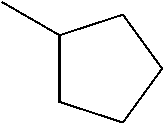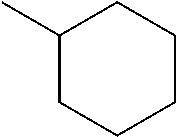Curable resins and articles made therefrom
a technology applied in the field of curable resins and articles made therefrom, can solve the problems of difficult to meet the requirements of high fracture toughness, high fracture toughness etc., and achieve excellent optical properties, low cure shrinkage, and high fracture toughness
- Summary
- Abstract
- Description
- Claims
- Application Information
AI Technical Summary
Benefits of technology
Problems solved by technology
Method used
Image
Examples
example 1
[0066]The optical properties, i.e. refractive index and Abbe number (dispersion), of linear and branched (meth)acrylate resins were compared to the optical properties of cycloaliphatic (meth)acrylate resins. The table below summarizes the results:
RefractiveAbbeIndexNumberMonomer StructureName(at 589 nm)(Vd)Trimethyolpropane triacrylate (“TMPTAc”) 1.511550.2Trimethyolpropane trimethacrylate ( “TMPTMA”)1.512149.51,4-Butanediol diacrylate (“BDDA”)1.507552.61,4-Butanediol dimethacrylate (“BDDMA”)1.511751.0Adamantylmethacrylate1.528953.1 ± 1.0Tricyclo [5.2.1.0] decane dimethanol diacrylate (“TCDDDA”) 1.530853.4 ± 0.3
[0067]In sum, the cycloaliphatic (meth)acrylate resins had both a higher refractive index and a higher Abbe number as compared to the linear and branched (meth)acrylate resins. The cycloaliphatic (meth)acrylate resins had a refractive index greater than 1.525 and an Abbe number greater than 53.
example 2
[0068]The optical properties, i.e. refractive index and Abbe number (dispersion), and Tg of numerous PT curable resins were evaluated as follows. The (meth)acrylate reagents and TATATO were purchased from Aldrich Chemical and used as-received. The thiol reagent (4T) was purchased from Evans Chemetics LP (Waterloo, N.Y.). A typical formulation involved mixing 2 g to 4 g of the desired monomer formulation with 0.5w / % of photoinitiator, PI (Irgacure 184, purchased from Aldrich). The monomers and the PI were mixed thoroughly using a Flacktek Speedmixer model DAC 150 FVZ-K. typical mixing protocol involved 3 minutes rotation at 2,000 rpm.
[0069]The mixed formulation was then poured into a rectangular mold (approximately 3 mm tall, 5 mm wide and 10 mm long). The bottom of the mold consisted of an elastomer gasket attached to a glass slide. After filling the mold with the resin, the mold was caped with a glass slide and the assembly was secured with spring-loaded clamps. The bottom and top ...
example 3
[0081]In a laboratory equipped with yellow lighting we added 4.5 g of 3-Methyl-3-oxetanemethanol (Prod. No. 277681 from Sigma Aldrich, Milwaukee, WI) and 4.5 g of Epoxypropoxypropyl terminated polydimethylsiloxane, 8-11 cSt (Prod. No. DMS-E09 from Gelest, Morrisville, Pa.) to a glass vial and mixed the liquids vigorously for 5 minutes using vortex mixer (Model K-550-g from VWR). Once mixed, the vial was degassed inside a vacuum desiccator to remove trapped air bubbles. In a separate 50 g capacity disposable container (from FlackTek, Landrum, S.C.), we weighed 21 g of the resin PCX-35-67B (epoxycyclohexyl siloxane and diaryliodonium hexafluoroantimonate (photoinitiator) from Polyset Company, Mechanicville, N.Y.), 4.5 g of 1,4-butanediol diglycidyl ether (from Sigma Aldrich, Milwaukee, Wis.), and added the pre-mixed solution 3-Methyl-3-oxetanemethanol and Epoxypropoxypropyl terminated polydimethylsiloxane. We blended the four-component system for 5 minutes at 2400 rpm using a speedmix...
PUM
| Property | Measurement | Unit |
|---|---|---|
| transparency | aaaaa | aaaaa |
| linear shrinkage | aaaaa | aaaaa |
| cure shrinkage | aaaaa | aaaaa |
Abstract
Description
Claims
Application Information
 Login to View More
Login to View More - R&D
- Intellectual Property
- Life Sciences
- Materials
- Tech Scout
- Unparalleled Data Quality
- Higher Quality Content
- 60% Fewer Hallucinations
Browse by: Latest US Patents, China's latest patents, Technical Efficacy Thesaurus, Application Domain, Technology Topic, Popular Technical Reports.
© 2025 PatSnap. All rights reserved.Legal|Privacy policy|Modern Slavery Act Transparency Statement|Sitemap|About US| Contact US: help@patsnap.com



